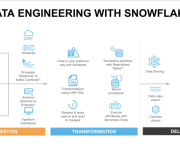Data Analytics: Unlocking New Efficiencies in Business Operations
According to Forbes, businesses deeply invested in data analytics are over twice as likely to land in the top quartile of financial performance within their respective industries. That’s a formidable edge in today’s marketplace. Essentially, data analytics allows companies to sift through mountains of data to discover vital insights, and these insights reveal what customers are genuinely interested in, which products are flying off the shelves, and what trends are looming on the horizon.
This significant advantage is the result of leveraging the power of data to stay one step ahead. By tapping into what the market wants—sometimes even before the market knows it—companies can tailor their strategies, products, and services to meet emerging demands.
The Efficiency Epicenter
Efficiency can be like sweet, sweet music to our overworked ears. When you’re up to your neck in tasks, dreaming of a vacay, that’s when efficiency becomes your jackpot. In business terms, efficiency means knocking out goals with the least amount of wasted time, effort, or cost. And that’s where data analytics comes in–it shows businesses exactly where they’re nailing it and where they’re just spinning their wheels. Suddenly, they can laser-focus on what really matters, slashing time and improving that bottom line. As Deloitte pointed out, companies utilizing predictive analytics can potentially see a 10% increase in supply chain efficiency.
Time: Save It to Make It
Turns out, time isn’t just money—it’s everything. Data analytics is like having a time-turner. By peeling back the layers on customer habits, market trends, and product performance, companies can anticipate the next big hit or miss. No more throwing spaghetti at the wall to see what sticks. This precision saves heaps of time, which can then be funneled into innovation, improvement, or just getting ahead of the competition.
Deadlines: Who’s Afraid?
Deadlines. Just the word can send shivers down the spine of even the most veteran professionals. But here’s where data analytics swaggers in. According to the Medium, organizations that are really good at using data and analytics tend to hit their targets and beat their deadlines more often. It’s impressive, isn’t it? It turns out, it’s not magic or a secret formula but merely using data in a smart way. With this technology they can avoid potential bottlenecks, predict project timelines with eerie accuracy, and can find themselves turning in projects not just on time but ahead of schedule. Can you imagine confidently hitting every deadline without the usual panic and chaos? Because it’s possible.
The Role Project Portfolio Management Tools
You may now be curious about the role of project portfolio management tools within the larger framework of business operations. They offer a consolidated overview of a company’s entire project portfolio, encapsulating progress, resource allocation, and projected outcomes in one unified interface. By integrating data analytics into the mix, the strategic value of PPM tools is markedly enhanced. This integration equips businesses with powerful insights, enabling more informed decision-making and optimizing operational efficiency. And what’s also really beneficial is that organizations are not only better positioned to manage their current project portfolios but are also more adept at planning for future initiatives.
It’s no wonder that in the digital age, data isn’t just king–it’s the entire kingdom.




























Leave a Reply